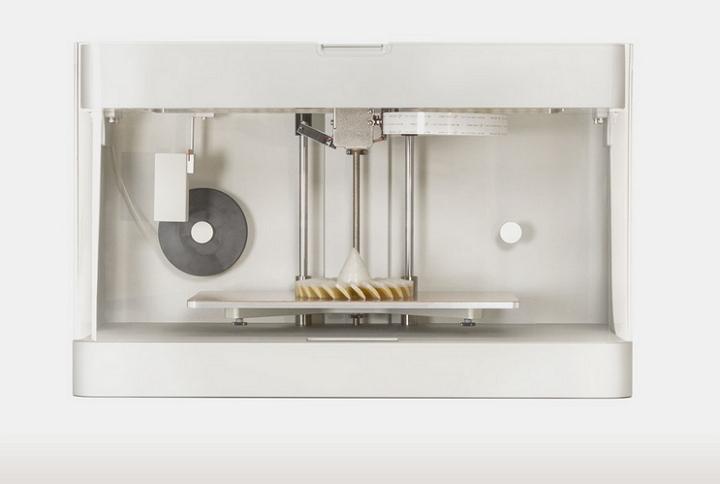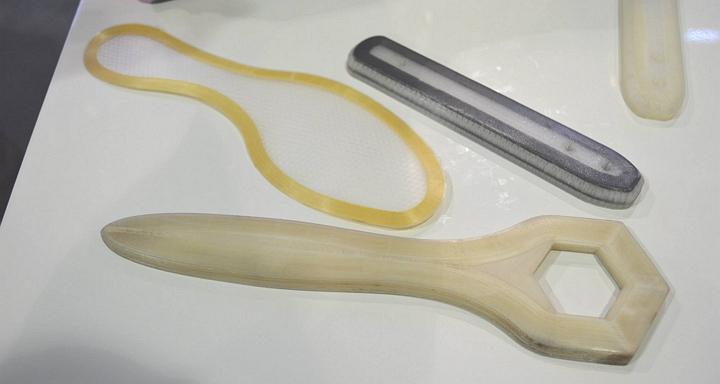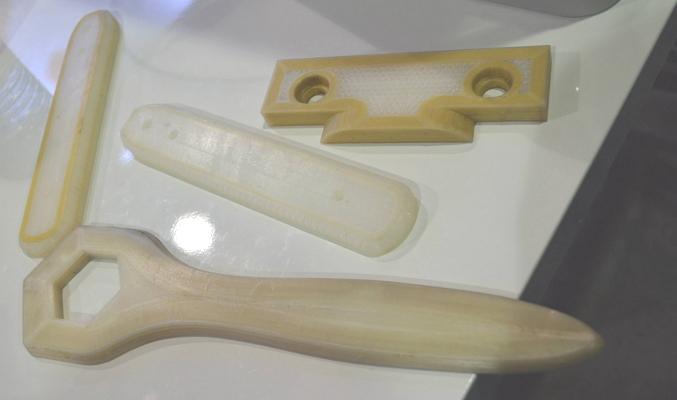MarkForged Releases Benchmark Data for Their Line of Carbon Fiber, Kevlar, Fiberglass, and Nylon Filament Formulations
 The Mark One 3D printer from MarkForged prints in carbon fiber, Kevlar, fiberglass, and nylon formulations. With a build volume of 320 x 132 x 160 mm, it makes use of one nozzle to print a plastic material as another nozzle prints the fiber material.
The Mark One 3D printer from MarkForged prints in carbon fiber, Kevlar, fiberglass, and nylon formulations. With a build volume of 320 x 132 x 160 mm, it makes use of one nozzle to print a plastic material as another nozzle prints the fiber material.
The finished parts appear similar to traditional FFF printed parts but include strands of fiber running through them. Parts that include just one or two layers of carbon fiber or fiberglass are exceptionally rigid, and MarkForged Creative Director Jeff Klein says the specifications for the strength of those parts and materials has now been officially benchmarked.
 Klein says that following months of rigorous testing, MarkForged has released these final material specifications for the company’s Fused Filament Fabrication and Continuous Filament Fabrication printing materials.
Klein says that following months of rigorous testing, MarkForged has released these final material specifications for the company’s Fused Filament Fabrication and Continuous Filament Fabrication printing materials.
While the company initially thought that their carbon fiber CFF was up to 5x stronger and 20x stiffer than ABS, Klein says these final numbers – some based on third party testing – show the parts are in actuality up to 30x stronger and 30x stiffer than similar parts printed in ABS.
The documentation and test results include data on the tensile, flexural, compressive, and heat deflection temperature testing for the material line-up of carbon fiber, Kevlar, fiberglass, and nylon formulations.
According to Klein, the carbon fiber material has the highest strength to weight ratio, as well as the highest thermal conductivity, which makes it ideal for applications requiring great stiffness and strength.
He adds that the fiberglass formulation is the most cost-effective material. While it’s as strong as carbon fiber, it’s some 40% as stiff and twice the total weight of a similar carbon fiber part.
MarkForged says the Kevlar formulation has the best abrasion resistance of the materials, and it’s the company’s most flexible material. This material is best suited to parts that require maximum durability and impact resistance.
The test pieces used to compile the data were fiber reinforced unidirectionally.
The company says the the Mark One Composite 3D printer can print a wide variety of fiber reinforcement patterns to create both anisotropic and quasi-isotropic ply constructions, and the data sheet provides reference and comparison material properties based on a set of standards-compliant ASTM plaques printed with a production version of the device.
Klein says that ultimately part and material performance will vary by the ply design, part design, end-use conditions, and he adds that this data listed should not be used to establish design, quality control, or specification limits.
Have you ever seen the Mark One 3D Printer at work or used parts made with one? Let us know in the MarkForged Releases Benchmark Materials Data forum thread on 3DPB.com.


Subscribe to Our Email Newsletter
Stay up-to-date on all the latest news from the 3D printing industry and receive information and offers from third party vendors.
You May Also Like
3DPOD Episode 198: High Speed Sintering with Neil Hopkinson, VP of AM at Stratasys
Neil Hopkinson, a pioneering 3D printing researcher, played a pivotal role in developing a body of research that is widely utilized today. He also invented High Speed Sintering (HSS), also...
GE Additive Transforms into Colibrium Additive in New Brand Move
One of the largest and most compelling companies in the 3D printing industry, GE Additive, has undergone a rebrand. Now, known as Colibrium Additive, the company and its new name...
HP & INDO-MIM Collaborate to Boost Metal 3D Printing in India
HP Inc. and INDO-MIM, a US- and India-based supplier of metal injection molding (MIM) powders and contract manufacturer, have announced that the two companies will collaborate to accelerate additive manufacturing...
Nylon 3D Printed Parts Made More Functional with Coatings & Colors
Parts 3D printed from polyamide (PA, Nylon) 12 using powder bed fusion (PBF) are a mainstay in the additive manufacturing (AM) industry. While post-finishing processes have improved the porosity of...
































